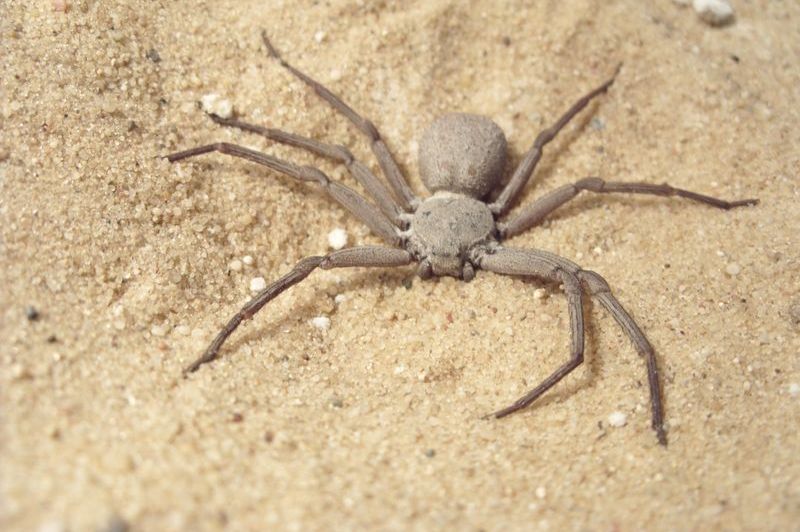We are going to learn today about an unusual little animal called Sicarius hahni, known as “the six-eyed sand spider.”
This spider belongs to the Sicariidae family, genus Sicarius. Its body measures 8 to 15 millimetres, and with legs, it reaches 50 mm. Due to its flattened conformation, it is named the six-eyed crab spider. The nickname derives from the fact that, unlike most spiders, this one has three pairs of eyes instead of four.
Sicarius hahni lives only in the sandy deserts of southern Africa called – the Kalahari Desert and in some areas of South America. It very rarely bites humans. On the other hand, its bite is so powerful that it can cause lesions several centimetres in diameter.
The six-eyed sand spider has the habit of burying itself in the sand! Yes, you’ve read it right! This spider has a very particular hunting technique: it buries itself in the sand to camouflage itself and waits for prey to pass before it jumps up on them.
Here we share a short video of this strange six-eyed sand spider to show you its fascinating technique of hiding itself in the sand and was recorded by Goro García Moreno, broadcasted on the YouTube channel Saminal Planet. Let’s know more about it…
Doesn’t this spider look cool? You can see how flawlessly it buries itself in the sand! We can see in this video; this arachnid-spider has a body covered with fine hairs called bristles. These are used to retain tiny grains of sand that the spider uses to hide itself even when it is not buried.
However, Sicarius hahni is a shy spider that shuns confrontation when it can, bites only when forced. It can live up to 15 years!
The Other Names Of Sicarius Hahni
The Common names are; Six-eyed sand spider, Six-eyed crab spider. Sicarius testaceus.
Interesting: Six-eyed Sand Spiders Don’t Move Often
The territory range for the Sicarius hahni is not expanding rapidly, due to the spider’s reluctance to move far from its origin spot. Based on the information gathered by studying the different exoskeleton sheds of these spiders throughout life, individuals remain in one place for most, if not all of their lives.
Another logic for not moving far is because of their dispersal approaches that do not include ballooning, mostly other spider species exhibit. Although, this spider’s habitat normally consists of shallow caves, between natural debris, and crevices. Moreover, they are most abundant in the fine sand-dunes, because of their talent to bury themselves and hide into the sand particles. This spider has created a better-fit environment for themself.
Six Eyed Sand Spider Diet
It feeds mainly on insects and also on scorpions. Moreover, to hunt, it hides under the sand where he patiently waits even for a long time. When a prey passes by, it kills it by injecting it the poison with a bite. Later, it calmly devours it.
These spiders don’t need to eat very frequently. The six-eyed sand spider can go without eating or drinking even for a few months!
Six-eyed Sand Spider: One Of The Most Venomous Spider On The Earth

Sicarius hahni is the second most poisonous spider on the planet. Moreover, to hunt, it buries itself in the sand. Its bite is not much painful, but it is lethal. Its venom destroys the body tissues and causes severe internal bleeding. Still, there is no antidote available. In this video document, the spider digs a hole in just seconds and it disappears under the sand. However, the most ridiculous point is that this spider in the video is someone’s pet! And the video detail was given by Sam Sheikali: “My Sicarius hahni burying herself.” It sounds crazy!
The Poison Of A Six-eyed Sand Spider
Of all spiders, the six-eyed sand spider has the most powerful venom of all. Its LD50 value is 0.004 mg/Kg. Fortunately it is a very shy spider, bites against humans are very rare. There are only two documented cases (one is uncertain), in which one man died and the other suffered an amputation.
Toxicological studies on the venom revealed a haemolytic and a necrotic component. In practice, the bite of the six-eyed sand spider causes severe bleeding and tissue necrosis. The bite was tested on rabbits that died within 5-12 hours of the bite.
Unlike other poisonous spiders, for which there is an antidote, for Sicarius hahni, as we mentioned above, still there is no antidote. Generally, for the bite of other spiders, you can recover completely due to availability of antidotes. Those who have the misfortune to receive its bite, on the other hand, either die or are severely disabled.
Reproduction Of Sicarius Hahni
The six-eyed sand spider reproduces by laying eggs wrapped in layers of web, called egg sacs. Subsequently, the mating is preceded by complex rituals before the male can fertilize the female.
Consequently, similarly to the black widow, the male of Sicarius Hahni also has to hurry away after mating. The risk is to be devoured by the female.
The YouTuber: Sam Sheikali
The YouTuber Sam Sheikali is a wildlife enthusiast and medical student. His channel is dedicated to wild adventures! And you may find so many interesting nature’s wild tastes on his YouTube channel called Saminal Planet.
We hope you enjoyed this post. Thank you for being with us. Stay tuned for more!
Resources
- Sicarius hahni Wikipedia
- Six-Eyed Sand Spider Burying Herself
- YouTube Channel: Saminal Planet.
